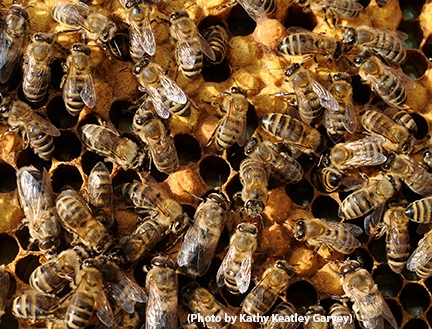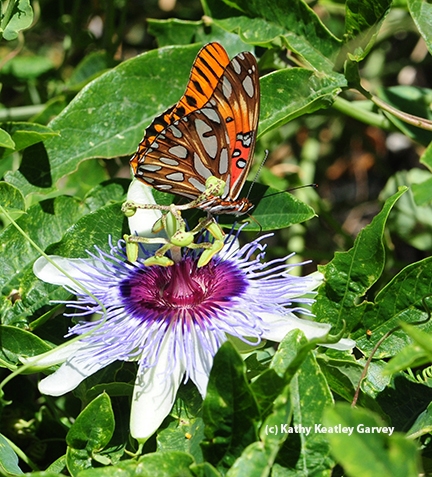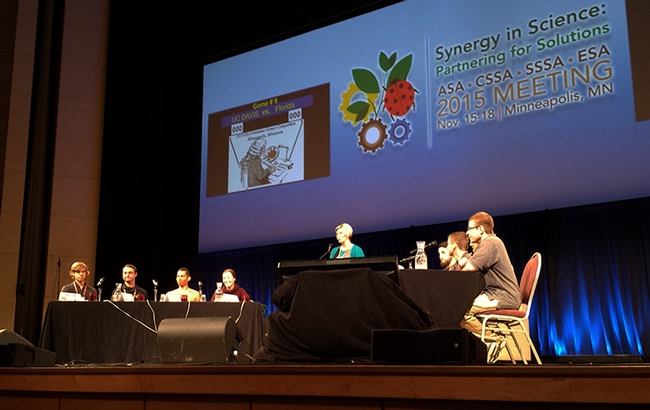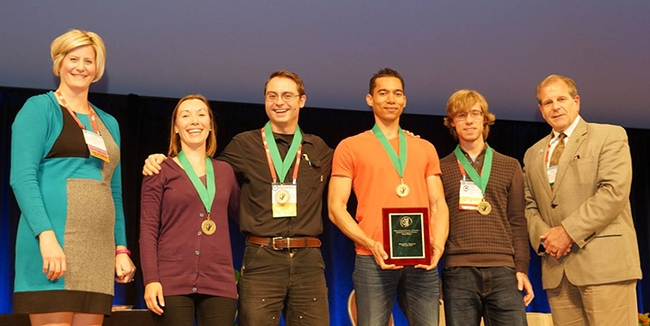
Okay then, "What are the three primary conditions that define eusociality?"
Or how about "Nicrophorus americanus is listed under what legislative act?”
Those are just three of the questions that the UC Davis Linnaean Games Team correctly answered to win the national championship at the Entomological Society of America's annual Linnaean Games competition, held recently in Minneapolis. UC Davis defeated the University of Florida 130 to 70.
The Linnaean Games is a college-bowl type competition in which teams answer questions about insects and entomologists. The teams hold practice sessions throughout the year. So much to know, and you never know what questions will be asked! And then you have to pounce on the buzzer quickly to beat the other team to the answer!
The UC Davis team is comprised of captain Ralph Washington Jr., and members Jessica Gillung, Brendon Boudinot and Ziad Khouri. All are graduate students in the UC Davis Department of Entomology and Nematology. They earlier won the Linnaean Games competition at the regional level: the Pacific Branch of ESA.
This is the first year in ESA's 32-year history that UC Davis has won the championship.

Washington is studying for his doctorate with major professors Steve Nadler and Brian Johnson, who respectively specialize in systematics and evolutionary biology of nematodes and the evolution, behavior, genetics, and health of honeybees; Boudinot with major professor Phil Ward, systematics and evolutionary biology of ants; and Jessica Gillung and Ziad Khouri with major professor Lynn Kimsey, who specializes in the biology and evolution of insects. Kimsey directs the Bohart Museum of Entomology.
Two members of the UC Davis Department of Entomology and Nematology faculty--Extension entomologist Larry Godfrey and Extension apiculturist Elina Niño--served as the team's advisors.
The questions that UC Davis correctly answered in the championship game:
Toss-Up Question: What is the smallest insect that is not a parasite or parasitoid?
Answer: Beetles in the family Ptiliidae.
Bonus Question: Some species of mosquitoes lay eggs that can undergo diapause or aestivation. Give at least three cues that trigger the aquatic eggs to hatch.
Answer: Temperature, immersion in water, concentration of ions or dissolved solutes.
Toss-Up Question: Chikungunya is an emerging vector-borne disease in the Americas. Chikungunya is derived from the African Language Makonde. What means Chikungunya in Makonde?
Answer: Bending up.
Toss-Up Question: A Gilson's gland can be found in what insect order?
Answer: Trichoptera
Toss-Up Question: Certain Chrysomelid larvae carry their feces as a defensive shield. To what subfamily do these beetles belong?
Answer: Cassidinae.
Bonus Question: The first lepidopteran sex pheromone identified was bombykol. What was the first dipteran sex pheromone identified? Give the trade or chemical name.
Answer: Muscalure, Z-9-Tricosene. It is also one of the chemicals released by bees during the waggle dance.
Toss-Up Question: What famous recessive gene was the first sex-linked mutation demonstrated in Drosophila by T.H. Morgan?
Answer: White
Bonus Question: Cecidomyiidae are known as the gall flies. What is unique about the species Mayetiola destructor, and what is its common name?
Answer: Mayetiola destructor is the Hessian Fly, a tremendous pest of wheat. It does not form galls.
Toss-Up Question: Nicrophorus americanus is listed under what legislative act?
Answer: The Endangered Species Act
Toss-Up Question: In what insect order would you find hemelytra?
Answer: The order Hemiptera.
Toss-Up Question: The subimago stage is characteristic of what insect order?
Answer: The order Ephemeroptera
Bonus Question: A 2006 Science article by Glenner et al. on the origin of insects summarized evidence that Hexapods are nothing more than land-dwelling crustaceans, which is to say that the former group Crustacea is paraphyletic with respect to the Hexapoda. What hierarchical name has been used to refer to this clade?
Answer: Pancrustacea
Toss-Up Question: What are the three primary conditions that define eusociality?
Answer: Cooperative brood care, overlapping generations, and reproductive division of labor
A total of 10 teams competed in the 2015 Linnaean Games:
Eastern Branch: Virginia Tech University and University of Maryland
North Central Branch: Michigan State University and Purdue University
Pacific Branch: UC Davis and Washington State University
Southeastern Branch: University of Georgia and University of Florida
Southwestern Branch: Oklahoma State University and Texas A&M
A YouTube video of the championship game--with all of the questions asked--will be posted soon. Last year North Carolina State University defeated the University of Florida to win the finals.
Attached Images:

This was the scene at the ESA Linnaean Games Championships: UC Davis on the left, and the University of Florida on the right. (Photo by Mohammad-Amir Aghaee, who received his doctorate in entomology from UC Davis and is now in a postdoctoral position at North Carolina State University)

National champions: Gamesmaster Deane Jorgenson (far left) and ESA president Phil Mulder (far right) pose with the UC Davis Linnaean Games Team, who won the national ESA Linnaean Games Championship.. Members In the center are (from left) Jessica Gillung, Brendon Boudinot, captain Ralph Washington Jr., and Ziad Khouri. (Photo by Matthew Chism)